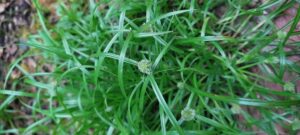Pest Alert – Sedges in Lawns and Ornamentals
go.ncsu.edu/readext?946049
en Español / em Português
El inglés es el idioma de control de esta página. En la medida en que haya algún conflicto entre la traducción al inglés y la traducción, el inglés prevalece.
Al hacer clic en el enlace de traducción se activa un servicio de traducción gratuito para convertir la página al español. Al igual que con cualquier traducción por Internet, la conversión no es sensible al contexto y puede que no traduzca el texto en su significado original. NC State Extension no garantiza la exactitud del texto traducido. Por favor, tenga en cuenta que algunas aplicaciones y/o servicios pueden no funcionar como se espera cuando se traducen.
Português
Inglês é o idioma de controle desta página. Na medida que haja algum conflito entre o texto original em Inglês e a tradução, o Inglês prevalece.
Ao clicar no link de tradução, um serviço gratuito de tradução será ativado para converter a página para o Português. Como em qualquer tradução pela internet, a conversão não é sensivel ao contexto e pode não ocorrer a tradução para o significado orginal. O serviço de Extensão da Carolina do Norte (NC State Extension) não garante a exatidão do texto traduzido. Por favor, observe que algumas funções ou serviços podem não funcionar como esperado após a tradução.
English
English is the controlling language of this page. To the extent there is any conflict between the English text and the translation, English controls.
Clicking on the translation link activates a free translation service to convert the page to Spanish. As with any Internet translation, the conversion is not context-sensitive and may not translate the text to its original meaning. NC State Extension does not guarantee the accuracy of the translated text. Please note that some applications and/or services may not function as expected when translated.
Collapse ▲Nutsedges and kyllingas can be a difficult-to-control perennial weeds in lawns and landscapes. Nutsedges and kyllingas are not grasses nor are they broadleaf plants. Sedges and kyllingas have pointy, v-shaped, sharp edged leaves and triangular stems; sedges have edges!
There are many different kinds. Some are native including Cherokee Sedge. Others are non-native such as yellow and purple nutsedge and kyllinga. Most of them like wet soils.
Sedges move into turf areas during wet weather. The leaves are distinctly different than turfgrass and the plants grow faster. This can make lawns less desirable.
Control
Sedges are difficult to control. The plant has tubers that grow along the root. Although the plant is easily removed by hand weeding, the tubers remain and grow back.
There are several herbicides that kill sedges. SEDGEHAMMER is safe to use for sedge control on fescue grass. It will also kill many broadleaf weeds.
According to the product’s website, “SEDGEHAMMER is one of the most “gentle- to- turf” products around. It has proven to be safe to most commonly used grasses of North America and has been successfully used for many years.” Also, “SedgeHammer+ can be safely used on a variety of cool and warm season turfgrasses including the following: creeping bentgrass, fine fescue, perennial ryegrass, Kentucky Bluegrass, tall fescue, bahiagrass, bermuda grass, buffalograss, centipede grass, seashore paspalum, St. Augustine grass, kikuyugrass and zoysia grass.”
***DO NOT use IMAGE sedge killer in your lawn because the chemical will kill fescue grass.
***Always READ AND FOLLOW THE LABEL when using pesticides








